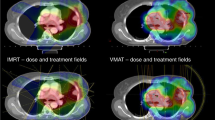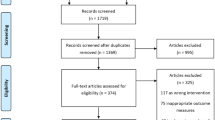Abstract
The aim of this study was to identify possible failure-specific prognostic factors in non-small-cell lung cancer. Clinical outcome was analysed in 549 patients participating in the randomized controlled trial of CHART vs conventional radiotherapy. Local failure and distant failure with or without concurrent local relapse were subjected to a competing risk analysis using an accelerated failure-time model with a log-logistic hazard function. Randomization to CHART (2P = 0.005), increasing age (2P = 0.036) and female sex (2P = 0.09) was all associated with a prolonged interval to failure. Advanced clinical stage was associated with a decreased interval to failure (2P = 0.004) and a significantly increased risk (2P = 0.009) of failing in distant rather than in local position. From this model, prognostic indices for local and distant failure were estimated for each individual patient. Competing risk analysis allows identification of patients with different failure patterns, and may provide a means of stratifying patients for intensified local or systemic therapy. © 2001 Cancer Research Campaign http://www.bjcancer.com
Similar content being viewed by others
Article PDF
Change history
16 November 2011
This paper was modified 12 months after initial publication to switch to Creative Commons licence terms, as noted at publication
References
Albain KS, Crowley JJ, LeBlanc M and Livingstone RB (1991) Survival determinants in extensive-stage non-small cell lung cancer: the Southwest Oncology Group experience. J Clin Oncol 9: 1618–1626
Ardizzoni A, Grossi F, Scolaro T, Giudici S, Foppiano F, Boni L, Tixi L, Cosso M, Mereu C, Battista Ratto G, Vitale V and Rosso R (1999) Induction chemotherapy followed by concurrent standard radiotherapy and daily low-dose cisplatin in locally advanced non-small-cell lung cancer. Br J Cancer 81: 310–315
Arriagada R, Kramar A, Le Chevalier T and De Cremoux H (1992) Competing events determining relapse-free survival in limited small-cell lung carcinoma. J Clin Oncol 10: 447–451
Ball D, Bishop J, Smith J, O’Brien P, Davis S, Ryan G, Olver I, Toner G, Walker Q and Joseph D (1999) A randomised phase III study of accelerated or standard fraction radiotherapy with or without concurrent carboplatin in inoperable non-small cell lung cancer: final report of an Australian multi-centre trial. Radiother Oncol 52: 129–136
Bentzen SM, Poulsen HS, Kaae S, Myhre Jensen O, Johansen H, Mouridsen HT, Daugaard S and Arnoldi C (1988) Prognostic factors in osteosarcomas A regression analysis. Cancer 62: 194–202
Bentzen SM, Thames HD, Travis EL, Kian Ang K, Van Der Scheren E, Dewit L and Dixon DO (1989) Direct estimation of latent time for radiation injury in late responding normal tissues: gut, lung, and spinal cord. Int J Radiat Oncol Biol Phys 55: 27–43
BMDP User's Guide (1992a), Version 7, ed. Dixon WJ. pp 825–864, Wiley
BMDP User's Guide (1992b), Version 7 ed. Dixon WJ. pp 825–864, Wiley
Chapman JW, Fish EB and Link MA (1999) Competing risk analyses for recurrence from primary breast cancer. Br J Cancer 79: 1508–1513
Ciampi A, Lawless JF, Mc Kinney SM and Singhal K (1988) Regression and recursive partition strategies in the analysis of medical survival data. J Clin Epidemiol 41: 737–748
Cox JD, Scott CB, Byhardt RW, Emami B, Russell AH, Fu KK, Parliament MB, Komaki R and Gaspar LEW (1999) Addition of chemotherapy to radiation therapy alters failure patterns by cell type within non-small cell carcinoma of lung (NSCLC): Analysis of Radiation Therapy Oncology Group (RTOG) trials. Int J Radiat Oncol Biol Phys 43: 505–509
Kalbfleisch JD and Prentice RL (1980). The statistical Analysis of Failure Time Data, 21–38, 179–188, John Wiley: New York
Komaki R, Scott CB, Byhardt R, Emami B, Asbell SO, Russell AH, Roach M, Parliament MB and Gaspar LE (1998) Failure patterns by prognostic group determined by recursive partitioning analysis (RPA) of 1547 patients on four radiation therapy oncology group (RTOG) studies in inoperable nonsmall-cell lung cancer (NSCLC). Int. J. Radiat Oncol Biol. Phys 42: 263–267
Kramar A, Pejovic MH and Chassagne D (1987) A method of analysis taking into account competing events: Application to the study of digestive complications following irradiation for cervical cancer. Statist Med 6: 785–794
Lagakos SW (1978) A covariate model for partially censored data subject to competing causes of failure. Appl Statist 27: 235–241
SAS/STAT User's Guide, (1993). SAS Institute: Cary NC 997–1025
Saunders M, Dische S, Barrett A, Harvey A, Griffiths G and Parmar M (on behalf of CHART Steering committee) (1999) Continuous, hyperfractionated, accelerated radiotherapy (CHART) versus conventional radiotherapy in non-small cell lung cancer: mature data from the randomised multicentre trial. Radiother Oncol 52: 137–148
Scott C, Sause WT, Byhardt R, Marcial V, Pajak TF, Herskovic A and Cox JD (1997) Recursive partitioning analysis of 1592 patients on four Radiation Therapy Oncology Group studies in inoperable non-small cell lung cancer. Lung Cancer 17: 59–74
S-Plus 4 Guide to Statistics, (1991). Data analysis products division, Math Soft: Seattle Wa 697–710
Sørensen JB and Østerlind K (1999) Prognostic factors: from clinical parameters to new biological markers. In Progress and perspective in the treatment of lung cancer, Van Houtte P, Klastersky J, Rocmans P (Eds). pp 1–21, Springer
Stevens CW, Lee JS, Cox J and Komaki R (2000) Novel approaches to locally advanced unresectable non-small cell lung cancer. Radiother Oncol 55: 11–18
Takigawa N, Segawa Y, Okahara M, Maeda Y, Takata I, Kataoka M and Fujii M (1996) Prognostic factors for patients with advanced non-small cell lung cancer: univariate and multivariate analyses including recursive partitioning and amalgamation. Lung Cancer 15: 67–77
Werner-Wasik M, Scott C, Cox JD, Sause WT, Byhardt RW, Asbell S, Russell A, Komaki R and Lee JS (2000) Recursive partitioning analysis of 1999 Radiation Therapy Oncology Group (RTOG) patients with locally advanced non-small cell lung cancer (LA-NSCLC); identification of five groups with different survival. Int J Radiat Oncol Biol Phys 48: 1475–1482
Wigren T (1997) Confirmation of a prognostic index for patients with inoperable non-small cell lung cancer. Radiother Oncol 44: 9–15
Author information
Authors and Affiliations
Rights and permissions
From twelve months after its original publication, this work is licensed under the Creative Commons Attribution-NonCommercial-Share Alike 3.0 Unported License. To view a copy of this license, visit http://creativecommons.org/licenses/by-nc-sa/3.0/
About this article
Cite this article
Ataman, Ö., Bentzen, S., Saunders, M. et al. Failure-specific prognostic factors after continuous hyperfractionated accelerated radiotherapy (CHART) or conventional radiotherapy in locally advanced non-small-cell lung cancer: A competing risks analysis. Br J Cancer 85, 1113–1118 (2001). https://doi.org/10.1054/bjoc.2001.2049
Received:
Revised:
Accepted:
Published:
Issue date:
DOI: https://doi.org/10.1054/bjoc.2001.2049



